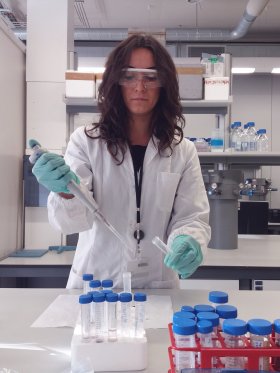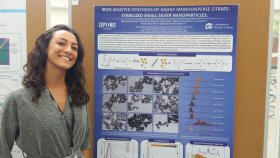Mariacristina Turino


PhD Programme: Nanoscience, Materials and Chemical Engineering
Research group: ZEPTONIC - Grupo de Plasmonica y Ultradetección
Supervisors: Ramón Álvarez-Puebla & Luca Guerrini
Bio
Mariacristina Turino completed her degree in Chemistry and Pharmaceutical Technology at University of Bologna. Her thesis research was about “Conjugates of Galantamine and memantine for the study of Alzheimer's disease: development of a new synthetic strategy”, in which she optimized the synthetic protocol of galantamine-memantine hybrid (PATENT N°WO2013160728A1) capable of modulating simultaneously two therapeutic targets (AChE and receptor NMDA) involved in Alzheimer's. After her degree, on September 2016, she started to work for Industria Chimica Fine, as a process technician; and she subsequently worked for U-Series as analytical chemist in Research and Development department. During this time, she optimized critical points of analytical methods for determination of radionuclides (plutonium, americium and uranium) in biological samples focusing the research on actinides purification step through ion exchange chromatography and chelating resin. From April 2017 to July 2017, she realized an initial traineeship as a research assistant at Andalusian Centre of Nanomedicine and Biotechnology, where she worked in nanochemistry field more specifically.
Project: Engineering plasmonic nanomaterials for SERS applications
Due to their exceptional properties, gold and silver nanoparticles have been used in a variety of applications, including those related to surface-enhanced Raman scattering (SERS) spectroscopy. In this regard, the increasing employment of this spectroscopic technique as an ultrasensitive analytical tool in a wide range of application fields, encouraged research in further improvements in the SERS substrates engineering. With these considerations in mind, the proposed dissertation aims to examine approaches for the design of novelty nanomaterials and expands the molecular library surface ligands that can decorate the plasmonic platforms with a special focus on SERS application. First, the formation of a smooth silver layer onto gold cores with different geometrical features through a cold nanowelding process was proposed as a new synthetical approach that overcomes the issues identified in the conventional chemical reductions of metal salts in solution. In particular, the conducted research has demonstrated the strong implication of some experimental parameters in the generation of bimetallic Au/Ag structures that retain the original gold substrate morphology. Secondly, a novel azobenzene derivative was synthesized as an efficient low-cost chemoreceptor for the SERS detection of clinically relevant low molecular weight thiols. More concretely, colloidally stable silver nanoparticle clusters were equipped with the obtained mercapto-azobenzene probe that, in the presence of biothiols, displays dramatic SERS spectral alterations quantitatively correlated to the small thiolated molecules-mediated breakage of the diazo bond. The dissertation finally reports a study conducted on the production of a metallic metamaterial. The resulting hybrid graded-index (GRIN) lens was obtained through the hierarchical assembly of gold nanoparticles onto a micrometric core of silica with the aim to examine the exotic optical properties to concentrate the light at the center of the microsphere deriving from the complex architecture.
Open Access publications
- Turino, M., Pazos-Perez, N., Guerrini, L., Alvarez-Puebla, R.A. Positively-charged plasmonic nanostructures for SERS sensing applications. RSC Adv., 2022, 12, 845-859. View full-text
- PHD THESIS: Engineering plasmonic nanomaterials for SERS applications
Outreach activities
- European Researchers’ Night 2019: “Nanoquímica, el món dels petits”.



